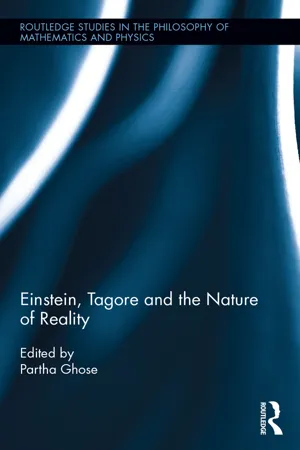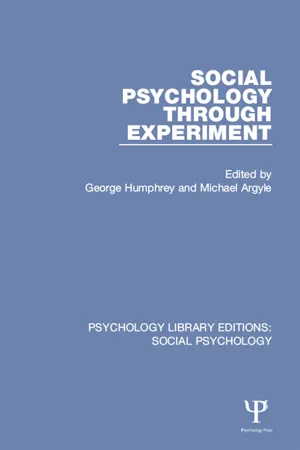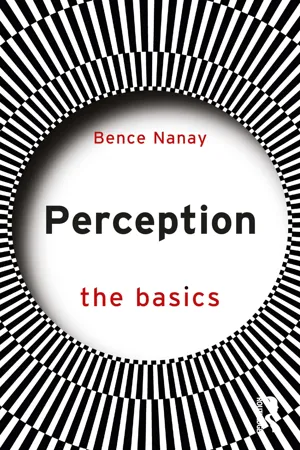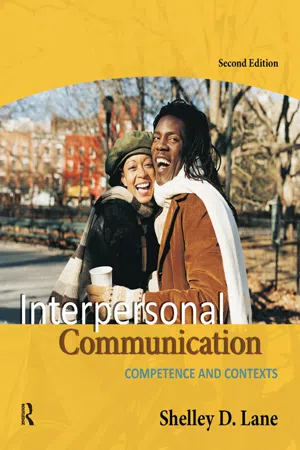Psychology
Influences on Perception
Influences on perception refer to the various factors that shape how individuals interpret and make sense of the world around them. These influences can include past experiences, cultural background, social environment, and personal beliefs. Understanding these influences is crucial in psychology as they impact how individuals perceive and interact with their surroundings.
Written by Perlego with AI-assistance
Related key terms
8 Key excerpts on "Influences on Perception"
- eBook - ePub
- Partha Ghose(Author)
- 2016(Publication Date)
- Routledge(Publisher)
There are four general factors that together influence the perceptual set: expectation, motivation, emotion and culture. The role of expectation takes place within the context of memory, which is a field vast enough to be outside the scope of this chapter. The remaining factors are briefly taken up in this section. There is a large body of literature on the many fascinating ways in which our perceptual experience can be affected by each of these factors. Motivation Let us make an assumption to start our discussion. The reader of this chapter is carefully attending to all that is written here. In other words, attention is focused specifically on the stimulus (visual) to apprehend the material. But why? What is it that is driving the attentional system in this situation? This very question illustrates how an internal cognitive force compels us to behave in certain ways that in turn drives our actions, such as the purposeful allocation of attention to a stimulus or how much effort we are willing to exert toward an outcome. The process that guides our actions in this regard is referred to as motivation. Psychologists have known for decades that a wide range of motivational effects can influence perception. One is the effect of bodily needs such as hunger on how food products are perceived, where certain foods appear to be brighter in colour. 28 The upshot here is that an internal state (hunger) drives the motivation to eat something and in turn makes the food appear brighter or more alluring. Another finding comes from a classic study on how poor and rich children perceive the size of money. 29 When presented with images of coins, children from poor families significantly overestimated the size of every coin compared to children from well-to-do families. It has been argued that these results show that motivation can affect the perception of size when it comes to money - eBook - ePub
Public Places Urban Spaces
The Dimensions of Urban Design
- Matthew Carmona(Author)
- 2021(Publication Date)
- Routledge(Publisher)
A growing literature focuses on understanding the multi-sensory experience of the urban environment (Lucas & Romice 2014; La Malva et al. 2015; Low & Kalekin-Fishman 2018). A common departure point is that sensory stimuli are usually perceived and appreciated as an interconnected whole, with Degen and Gillian (2012) reporting that even people visiting very ordinary places report a range of sensory engagements with those places that are multi-sensory. Thibaud (2011) terms this multi-sensory experience an ‘ambience’ and argues that it “gives access to the various moods and emotional tones of urban life”. Indeed, individual senses can only be separated by deliberate action (i.e., closing one's eyes, blocking one's nose or ears) or by employing selective attention.Perception
Perception (sometimes, confusingly referred to as ‘cognition’) concerns more than how we sense the urban environment and refers instead to the more complex processing or understanding of stimuli. Ittelson (1978) identifies four types or dimensions of perception, each operating simultaneously:- Cognitive, involves the thinking about, organising and keeping of information about the environment. In essence, it enables us to make sense of the environment.
- Affective, involves our feelings, which in turn influence our perception of the environment; equally, our perception of the environment influences our feelings.
- Interpretative, encompasses the meaning or associations derived from the environment. In actively processing information, we rely on memory of past stimulation for comparison with newly experienced stimuli.
- Evaluative, incorporates values and preferences and the determination of ‘good’ or ‘bad’ elements in the environment.
Rather than simply a biological process, perception is socially and culturally learnt. While sensations may be similar for everyone, individuals filter, react to, organise and value those sensations differently. These differences in environmental perception can be attributed to a number of factors: age, gender, ethnicity, lifestyle, length of residence in an area, usual mode of travel, and so forth; but also to the physical, social and cultural environment in which we live and were raised. - eBook - ePub
- George Humphrey, Michael Argyle(Authors)
- 2015(Publication Date)
- Psychology Press(Publisher)
Chapter 1 SOCIAL PERCEPTION HENRI TAJFELOxford UniversitySocial perception is not one of the best ordered areas of enquiry in psychology. Some of it is hardly ‘social’; some hardly ‘perceptual’. Investigations, referred to in one context or another as concerned with it, add up to a patchwork, not to a pattern. Therefore, to attempt a definition (or a series of definitions) of social perception would be a sterile task. Loosely, this blanket term stands for an agglomeration of studies attempting to find some regular and predictable relationships between man’s general orientation towards his environment, and the multitude of social factors which, in one way or another, determine this orientation or contribute to it.These relationships may be of several kinds. For example, social influences may affect our perception of the physical environment. Conversely, changes in the physical environment may affect the way in which we react to various aspects of our social environment. As any addict of Punch or of New Yorker knows, only a precarious hairbreadth distinction separates the dignified from the ridiculous: let the rain fall, or the scene be set in a tent in the jungle, and the otherwise respectable habits of dress, speech, gesture, or courtesy become fit material for a collection of ‘funniest cartoons of the last fifty years’.These relations between the ‘physical’ and the ‘social’ represent one only amongst the trends of interest in social perception. Our social environment consists, in the main, of people, of the ways in which they behave towards each other and towards ourselves. It is an extremely complex environment, and in order to make sense of it we must simplify, classify and label. An individual may be of interest to us either as a member of a specified group or class of people, or in his own unique capacity. To an anti-Semite, a Jew may appear as having certain attributes: the interpretation of the Jew’s appearance and actions may have its roots, entirely or predominantly, in the fact that he is known to be a Jew, and it may be to a large degree independent of the individual differences between Jews. At the other extreme, an intimate friend may be perceived or judged as being possessed of one attribute or another, independently of whether he is a Siamese, a lawyer, or a mountaineer. - eBook - ePub
- Bence Nanay(Author)
- 2024(Publication Date)
- Routledge(Publisher)
Where does this leave us with regard to the circularity worry, that is, the unbiased nature of perception? If cognitive processes influence perception, then perception can’t be taken to be an unbiased guide to how the world is. We always see the world through the veil of the prejudices our beliefs and other cognitive processes provide.Is this really a worry? Remember what the perceptual system is supposed to do. It has the incredibly difficult task of putting together a representation of the features of the world around us on the basis of very sparse input that we receive through the senses. If the perceptual system is to come up with the most likely model of the world around us, it is better off using all kinds of information that it has about the likely layouts and the most probable arrangements of features. And this very much includes information that is stored outside the perceptual system.In other words, the fact that perception is not unbiased is not necessarily a bad thing. Paradoxically, if it is biased, it could give us a more accurate representation of the world around us. And the best demonstration of this is perceptual learning (I want to leave open the question about whether perceptual learning counts as top-down influence – the point is that the bias it introduces is not a negative influence).As we have seen in Section 1.4 , perceptual learning is the psychological phenomenon that perceiving a certain kind of stimulus leaves a mark on the perceptual system, so the next time you perceive a similar kind of stimulus, your perception of it will be different. Because of perceptual learning, our perception depends on past perceptual episodes – on what kind of perceptual stimuli we’ve encountered before. Our imprinted perceptual history (dictated by what we have encountered throughout our lives and especially in our early formative years) has an impact on how we perceive the world now.Perception is not a fixed mechanism. It changes over our lifetime. What you perceive now influences how you perceive the world later. In some cases, this influence can be quite radical. Consider the example of perceptual discrimination (see Stokes and Nanay 2020 ). Fingerprint experts can differentiate two very similar fingerprints quickly and reliably – in a way novices cannot. Before undergoing extensive forensic fingerprint training, the expert looked at the very same stimulus she does now, but her perceptual processes and her perceptual experience are very different. We know from a number of empirical studies that this change entails a change in the way her perceptual system works (see Busey and Parada 2010 , Jarodzka et al. 2010 - eBook - ePub
- Terry McMorris(Author)
- 2014(Publication Date)
- Wiley(Publisher)
2 Sensation and Perception of External InformationLearning objectives
At the end of this chapter, you should be able to:- understand what is meant by indirect or inferred perception
- describe how information processing theorists explain perception, with particular reference to:
- – signal detection theory
- – nature and role of selective attention
- – nature and role of visual search
- – how individual differences affect perception
- understand what is meant by direct perception
- have a basic knowledge of how ecological psychologists explain perception, including
- – nature and importance of affordances
- – how perception and action interact to detect affordances
- understand the main criticisms of information processing and ecological psychology theories with regard to perception
- be aware of the main developmental factors affecting perception.
In this chapter we examine, from an information processing perspective, how we perceive external information particularly for the purposes of making decisions. From an ecological psychology stand point, we are looking at how perception and action combine to recognize the existence of affordances in the environment. The role of perception in the control of movement is covered in Chapter 6 .Information processing theory, sensation and perception
Although information processing theorists argue that sensation and perception are different, the two concepts tend to be treated as one. The senses, which are the most important in the perception of information for decision making, are visual and auditory receptors. Vision is generally considered to be the most important of the senses. Light rays enter the eye through the lens and are detected by the retina. The central portion of the eye, the fovea, is rich in nerve receptors, which allow it to extract detail from an object. The range of foveal or central vision depends on how the eye is focused. This is controlled by the ciliary muscles, which are on either side of the lens. The range is generally regarded as being between 2° and 5°. The vision outside of this range is referred to as peripheral vision. The receptors, here, are less dense and images are less distinct than those found in foveal vision. Although foveal and peripheral vision are commonly used terms, Trevarthen (1968) used the terms focal and ambient vision. Focal vision is identical to foveal vision, but ambient vision differs a little to peripheral vision. According to Trevarthen, ambient vision - eBook - ePub
- Zevedei Barbu(Author)
- 2019(Publication Date)
- Routledge(Publisher)
The physiological approach is still holding its ground in this field. Thus, perception is often explained entirely in terms of the specific organization of the sense organs, on the one hand, and of the nature of the stimulus, on the other. Lately, however, a different approach, a more comprehensive one, has developed side by side with the physiological one. The way in which the individual perceives his world is seen more and more in the function of his basic interests, beliefs and values, or even of some unconscious structures and mechanisms. Thus, perception has come to be regarded as a personality factor, i.e., as a mode of reaction reflecting not only the bio-physiological makeup of an individual, but also the specific organization of his mind within a given socio-cultural setting. In any perceptual process the individual selects from the multitude of stimuli presented to him; he organizes the field of perception by emphasizing some aspects and rejecting others. In any such process, the personality of the individual is an active factor of the first rank. If, for instance, someone is presented with a number of written words at a certain distance, he perceives more quickly and more distinctly those which appeal to his own interests and values. Though the size of a coin and that of a metal disc is objectively the same, the former is normally perceived as being bigger than the latter. 1 Furthermore, one often speaks about defence mechanisms operating in the field of perception. M. Gilbert, for instance, speaks about the ‘obviating’, ‘diverting’ and ‘constricting’ functions of beliefs and prejudices in the individual’s perceptual field. The members of the Nazi group perceived more readily events and phenomena which supported their basic beliefs and values, obviating, at the same time, those which contradicted these beliefs and values. 2 The degree of articulation of the individual’s inner life is another factor interfering with the structure of the perceptual field - eBook - ePub
Introductory Psychology
AN APPROACH FOR SOCIAL WORKERS
- D R Price-Williams(Author)
- 2013(Publication Date)
- Routledge(Publisher)
IVPerceptionTHE German psychologist Koffka once introduced the study of perception by stating the question: "Why do things look as they do?", a question which might be supplemented by further enquiries of "Why do people appear as they are?" and "Do other people see me as I see myself?" The subject of perception can be studied from different viewpoints; answers to the first question will be discussed in the first two sections of this Chapter, answers to the second and third questions, in the last two sections.The Process of Perception
Perhaps the most astonishing fact about our perception of things and people, is that they appear to be not a mass of impressions but assume a recognisable organisation. An apple does not appear to us as a combination of complex sensations of shape and colour; it merely is-an apple. Sensation is aroused by the interaction of our sense organs with energy in the form of electromagnetic waves outside of us. Seeing, for example, is the result of waves reaching the photosensitive layer of the eye which is called the retina. Hearing is the result of waves stimulating the eardrums. From the retina and the eardrums electrical impulses are transmitted along the nerve fibres to areas in the brain (the cerebral cortex: see Chapter VI ) which receive these impulses. When this process is completed, we say "I see the apple" and "I hear the bell". If we regard perception solely from this point of view of the transmission of sensations we might conclude that "so far as the receptor areas of the cortex were concerned, the external environment would be supposed to consist of a mass of sight, sound, taste, smell, touch, pain, heat and cold, pressure, joint and muscle sensations, each differentiated more or less accurately in intensity, extensity, localisation, and duration; and also in certain qualities such as colour, pitch, etc., which were peculiar to the type of sense organ stimulated".1 - eBook - ePub
Interpersonal Communication
Competence and Contexts
- Shelley D. Lane(Author)
- 2016(Publication Date)
- Routledge(Publisher)
CHAPTER 2 Perception and Communication
DOI: 10.4324/9781315506173-2“Perception is a guess or estimate of what is ‘out there' depending on how we read the clues; therefore it can never be absolute and often is unreliable.” Earl Kelleym, educatorIn this chapter, we will answer the following:Motivation: How will this help me?- It is important to study perception and communication because we often communicate on the basis of different perceptions. Additionally, engaging in perspective taking to understand others’ perceptions can improve our communication competence.
Knowledge: What will I learn?- How to characterize perception
- The stages involved in the perception process
- Perceptual biases and how they affect communication
- How contexts influence perception and communication
Skill: Why do I need to develop this skill?- Describing sense data and perception checking can improve our communication competence.
IIllusionist David Copperfield influences his audiences to perceive that he can levitate across the Grand Canyon, escape from Alcatraz Island, and make the Statue of Liberty disappear. What factors affect how we perceive and what we perceive as “real”? Do you or someone you know perceive that “all [fill in the blank with a particular group] are [fill in the blank with an adjective]”? Have you and a partner ever argued about whose perceptions are correct? In reality, perceptual differences don’t necessarily mean that one person’s version of “truth” is better than another’s. Try to recall some instances of perceptual disagreement as you read the material in this chapter regarding perception in general and how our perceptions of others influence our interpersonal communication. In this chapter, we will increase our motivation to communicate competently by learning why it’s important to study perception and communication. Engaging in perspective taking can increase our motivation to communicate with others who are different from us. We will also increase our knowledge by learning about the characterization of perception, the stages in the perception process, how our perception of reality is biased, how our perception is influenced by contexts, and the challenges of perception and communication as they relate to stereotyping and prejudice. Finally, we will learn two skills that can improve our interactions with others—how to communicate descriptive rather than inferential statements, and how to engage in the skill of perception checking.
Index pages curate the most relevant extracts from our library of academic textbooks. They’ve been created using an in-house natural language model (NLM), each adding context and meaning to key research topics.







